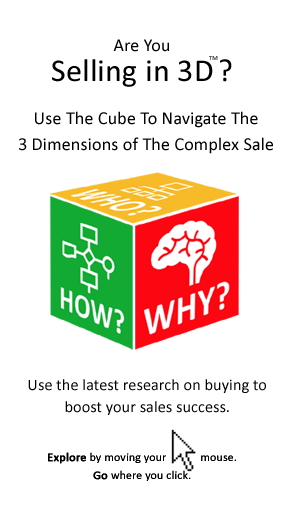Added on June 20, 2010
John O' Gorman
Buying Decisions , dissatisfaction , Sales Meetings , savvy sales , Uncategorized

How Misreading the Buying Decision Could Cost You the Sale
Key lessons from Neil Rackham’s ‘Major Account Sales Strategy’
‘Major Account Sales Strategy’ by Neil Rackham’s is a bible for the savvy sales professional. It is as relevant today as when it was first published in 1989. So, we dusted it off and pulled out its key points.
The key message of this ground-breaking book is that many sales are lost because salespeople misread the stage of the buying decision.
For example, they try to sell a solution before the buyer’s needs have been recognized, or dig around to identify needs when they should be addressing the specific supplier selection criteria set by the buyer. Perhaps most serious of all they fail to unearth buyer concerns that could stall the sale.
Now, like me you know that no two buying decisions are the
same and that buying models can be an over-simplistic
representation of reality of how complex business decisions are made.
However, Rackham’s provides food for though in terms of how the key success factors for the salesperson varies depending on the stage of the buying decision. So, let us look at the 5 key stages:
Buying Phase 1: RECOGNITION OF NEEDS:
If there is no need there is no sale, that is obvious. So, the first stage in the buying process is the recognition of needs. That is also the starting point for most sales meetings, or at least it should be.
In the recognition of needs phase the ideal strategy for the salesperson is to uncover dissatisfaction and develop it until it reaches a critical mass. That means the salesperson should hold back on product discussions and presentations, focusing instead on identifying needs, probing dissatisfaction and creating tension for change.
Successful salespeople ask a lot more and better questions during sales calls than their less successful colleagues. The latter tend to do most of the talking and become involved in product discussions very early in the sale and give presentations as a means of generating customer interest.
Buying Phase 2: EVALUATION OF OPTIONS:
Once the buyer has recognized the need the next step is to evaluate options, that is solutions and suppliers. At this stage the sales person must ascertain if the decision making criteria have been defined and indeed are correct.
The salesperson’s objective for this phase of the buying process is to identify, address and shape the criteria that will be employed in selecting a supplier. It is also important to identify alternatives solutions to the buyer’s problem, or alternative uses for the same budget – these can be as important as any competiting vendor.
Rackham points out that most salespeople do not ask customers about their specific decision making criteria. Without this information they are shooting in the dark. After all there is no point emphasizing criteria that are not important to the buyer.
The salesperson may attempt to redefine, or diminish the importance of buying criteria that do not favour his/her company. Although these criteria will be both hard and soft, the savvy salesperson will attempt to quantify and ‘objectify’ both.
Of course, the line between evaluating options and recognizing needs can be a fine one, with the salesperson often attempting to influence the buying criteria by revisiting needs. For example, the customer says ‘we want a training programme’. But the salesperson in an attempt to prove his/her value may ask ‘What is the problem that the company is trying to solve?” ‘What are the issues that give rise to the need for training?’ and so on.
However, if a buyer may wans training and that is that. It is a transaction and there is little room for consultation and little buyer patience for recognition of needs questions on the part of the salesperson. In that situation the salesperson may be best served to focus attention on the buyer’s criteria for selecting a training provider.
Buying Phase 3: THE RESOLUTION OF CONCERNS:
While the salesperson may feel that he, or she is in pole position, getting the buyer across the line can often prove troublesome. Beneath the surface the buyer may be wrestling with fundamental, yet often hidden, concerns, sensitivities or risks that have the potential to scupper the sale. This crucial phase of the buying process is what Rachman calls ‘the resolution of concerns’.
Let us take an example: the salesperson’s proposal, presentation and price beats the competition, but somebody on the buying group raises a concern about the company’s track record and credibility – afterall the company is relatively new. The question is asked ‘why don’t we just stick with the supplier we know?’ Nothing is said to the sales person and the safe route is taken by the buying group.
Perhaps the salesperson had been sensitive to the issue during the sales process, but side stepped it in the hope that it would go away. After all, bringing it up in the discussion might only give it credence. This can be a fatal flaw however as sensitivity to risk is likely to increase, rather than diminish as the buying decision approaches. Ferreting out any lingering concerns on the part of the buyer is essential and can require almost a sixth sense on the part of the sales person.
Buying Phase 4: DECISION
The buyer’s needs are clear, the options have been explored and any niggling concerns addressed. So, logically the buying decision follows. Just as a good house sits on a strong foundation, the success of the salesperson depends on how well the recognition of needs, evaluation of options and resolution of concerns stages has been managed.
Like me Rackham does not believe in the ‘slam dunk’ sales close, pointing out that applying pressure to close before any unresolved issues have been addressed is generally a disaster. So too with negotiating too early. Until the buyer has moved from identification of needs to the evaluation of options and then resolved of concerns the salesperson’s job is not complete.
Buying Phase 5: IMPLEMENTATION
A continuous theme of Rackham’s book is that just as the salesperson things his/her job is done, another vital phase of the sales process is just about to begin and that includes implementation.
In particular the area of implementation is often overlooked, as the salesperson moves on to close the next deal. This is in spite of the importance of giving the customer extra attention during the early stages of implementation and the requirement to continually build the relationship and prove the value.
The mindset required is Rackham suggests that of account development, as opposed to account maintenance. What counts with most customers is what are you done for them today and what can you do for them tomorrow. In this respect it is also important to document the good news ensuring that the customer has an accurate measure of what has been achieved.
Related
John O' Gorman is a Business to Business sales coach, Director of The ASG Group and co-author of the ground-breaking book, The B2B Sales Revolution. John works with sales teams and sales managers across Europe to accelerate sales using the sales performance solution; SellerNAV.




































You must be logged in to post a comment Login